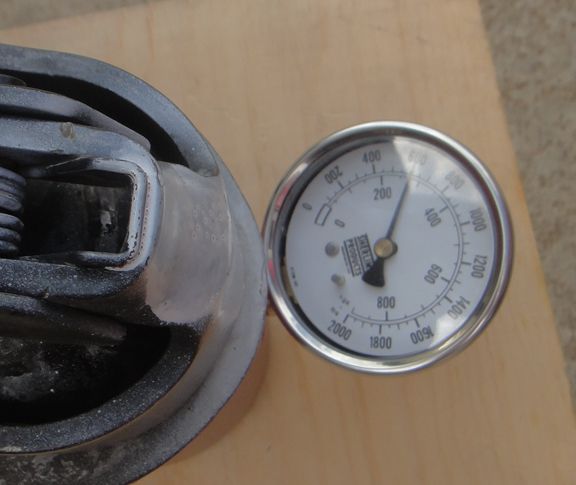(truth be told, I hauled farm equipment on a low boy in seven Midwestern states, no really challenging math involved)
Calling MelissaD, Calling MelissaD
22 posts
• Page 2 of 2 • 1, 2
Re: Calling MelissaD, Calling MelissaD
Melissa, thanks for the detailed reply, that made perfect sense to me. You'd never know I used to drive a semi for a living, would you. 
(truth be told, I hauled farm equipment on a low boy in seven Midwestern states, no really challenging math involved)
(truth be told, I hauled farm equipment on a low boy in seven Midwestern states, no really challenging math involved)
~Mickie & Mary
-

Queen - Posts: 1069
- Joined: Tue Aug 02, 2011 8:46 am
- Location: Illinois
Re: Calling MelissaD, Calling MelissaD
Speaking of lowboys Queen, you'll enjoy this little story. Back around 1998 in the days before everyone had a cell phone and they were expensive, there was a company that tried to install phone lines in parking lots to give drivers phone and dialup internet (yep, stone age) access right in their trucks. They mounted what looked like heavy metal dooms (think 1/3rd of a basketball) in the asphalt about 6" high. I told they guy mounting them they would never last and he stated they were nearly indestructible and big truck save. Just then a lowboy pulled in the lot and made a turn and that trailers sheared off about a 1/2 dozen of them connections sending them shooting across the lot. I said "yep, truck proof" and walked away.
- MelissaD
- Posts: 1382
- Joined: Sun May 19, 2013 9:26 pm
- Location: Fort Wayne, IN
Re: Calling MelissaD, Calling MelissaD
I drove for a seed corn company and we had to stop in to an office up in Michigan to pick up some field maps (the 80's long before the internet), had the guy try to give me directions into a corporate office park that had a speed bump about every 50 feet, yeah, NO!
~Mickie & Mary
-

Queen - Posts: 1069
- Joined: Tue Aug 02, 2011 8:46 am
- Location: Illinois
Re: Calling MelissaD, Calling MelissaD
..
My Sherline scale came today. I was going to ask this question of Melissa via PM because I figure you're all sick to death of hearing about this issue. But her answer might help someone else in the future.
With the trailer dropped onto the scale, the tongue weight is 600 lbs. YAYAY! That is within the truck's range.
My, hopefully final, question is this: 600 lbs. on the tongue is without the weight distribution engaged (truck is not hooked up).
For the sake of this question, let's just assume that my WD is adjusted to transfer 200 lbs. to the front axle of the truck.
Would this mean that with the WD engaged, the tongue weight on the truck is 400 lbs. (600 lbs. - 200 lbs. = 400 lbs.)?

Well, dang - I just realized I forgot the weight of my hitch & bars - approximately 84 lbs.
My Sherline scale came today. I was going to ask this question of Melissa via PM because I figure you're all sick to death of hearing about this issue. But her answer might help someone else in the future.
With the trailer dropped onto the scale, the tongue weight is 600 lbs. YAYAY! That is within the truck's range.
My, hopefully final, question is this: 600 lbs. on the tongue is without the weight distribution engaged (truck is not hooked up).
For the sake of this question, let's just assume that my WD is adjusted to transfer 200 lbs. to the front axle of the truck.
Would this mean that with the WD engaged, the tongue weight on the truck is 400 lbs. (600 lbs. - 200 lbs. = 400 lbs.)?

Well, dang - I just realized I forgot the weight of my hitch & bars - approximately 84 lbs.
- mitch5252
- Posts: 9229
- Joined: Fri Mar 13, 2009 5:47 pm
- Location: NW TN
Re: Calling MelissaD, Calling MelissaD
Whoa, am I glad I don't have a trailer. My mind is spinning with all these numbers. I could never figure it out.
Sandi
Sandi
Bindi (Maltipoo) and Abby (Shih Tzu/Poodle)

"Without the animals men would die of a great loneliness of the spirit." ~ Chief Seattle
“A dog can change the way you see the world.” ~ Anyone who has a dog

"Without the animals men would die of a great loneliness of the spirit." ~ Chief Seattle
“A dog can change the way you see the world.” ~ Anyone who has a dog
-

monik7 - Posts: 3016
- Joined: Sat Aug 04, 2012 7:49 pm
- Location: San Francisco Bay Area
Re: Calling MelissaD, Calling MelissaD
..
Not a problem, Sandi - I am a HUGE worry wort.
What I learned from all this is to NOT take recommendations from someone without doing my own research - both the truck AND the trailer. UGH. But anyway, I'm good to go.
And I lied - I have ONE more question - Melissa, from the first screen shot of my numbers, you determined that about 320# had been transferred off the hitch onto the front axle of the truck, correct? (either you or Laura said that...)
Anyway, assuming I do not adjust the Equalizer hitch - no matter what the tongue weight is (like say I put the propane tank back and add a second battery, but DO NOT adjust the Equalizer), will that 320# always be transferred? To change that 320# weight transfer, must the Equalizer hitch be adjusted? Or does the 320# change with the weight at the tongue area?
It's hard to formulate questions when you're not sure what you're asking!
..
Not a problem, Sandi - I am a HUGE worry wort.
What I learned from all this is to NOT take recommendations from someone without doing my own research - both the truck AND the trailer. UGH. But anyway, I'm good to go.
And I lied - I have ONE more question - Melissa, from the first screen shot of my numbers, you determined that about 320# had been transferred off the hitch onto the front axle of the truck, correct? (either you or Laura said that...)
Anyway, assuming I do not adjust the Equalizer hitch - no matter what the tongue weight is (like say I put the propane tank back and add a second battery, but DO NOT adjust the Equalizer), will that 320# always be transferred? To change that 320# weight transfer, must the Equalizer hitch be adjusted? Or does the 320# change with the weight at the tongue area?
It's hard to formulate questions when you're not sure what you're asking!
..
- mitch5252
- Posts: 9229
- Joined: Fri Mar 13, 2009 5:47 pm
- Location: NW TN
Re: Calling MelissaD, Calling MelissaD
I'm not an expert on the WDH bit if the scale reads 600# then your hitch weight is 600#. WDH will not someone from being overweight, it helps ensure you can control the vehicle.
Since your steer 2,560# just the truck and 2,460# with your WDH, your still 100# lighter on your steers. Check your heights but you might try another link if your front still is higher than normal. Should be within 1/2" according to video from Curt Hitches.
When you hitch the trailer to your truck the rear axle acts like a pivot (think see-saw) and lifts the front end some. This reduces the weight on the front/steer tires and effects your steering. The WDH acts to lift the rear truck axle putting weight back onto the steer tires so you can properly control the truck. The WDH when properly adjust should return the front/rear bumper heights to their original unloaded ride heights (+/- 1/2"). In adjusting the ride height, the weight should return to the original ratios and protect your ability to steer.
If you change the weight on the hitch IE add battery or move gas bottle you may have to adjust the WDH but that amount of weight may not actually be enough to warrant taking up another link. I'd think it depends if it affects your ride heights. It will affect your tongue weight and your scale will tell you that. Good tool that scale.
Ever ride in a golf cart when heavy people are siting in the back and someone light is driving? The front end tends to lift/drift around making it hard to steer. It's the same principle with a TT. A 5th wheel or gooseneck trailer gets around this by putting the hitch about 1" forward of the rear axle. This places 99% of the weight over the weight on the rear axle and the 1% which goes forward to the steers which mean when you accelerate the steer tire stay on the road so you can control/steer your truck.
This is a pretty good video and may help.
How To Set up A Weight Distribution Hitch - CURTmfg.com https://www.youtube.com/watch?v=mkewkvU8Ot8
Since your steer 2,560# just the truck and 2,460# with your WDH, your still 100# lighter on your steers. Check your heights but you might try another link if your front still is higher than normal. Should be within 1/2" according to video from Curt Hitches.
When you hitch the trailer to your truck the rear axle acts like a pivot (think see-saw) and lifts the front end some. This reduces the weight on the front/steer tires and effects your steering. The WDH acts to lift the rear truck axle putting weight back onto the steer tires so you can properly control the truck. The WDH when properly adjust should return the front/rear bumper heights to their original unloaded ride heights (+/- 1/2"). In adjusting the ride height, the weight should return to the original ratios and protect your ability to steer.
If you change the weight on the hitch IE add battery or move gas bottle you may have to adjust the WDH but that amount of weight may not actually be enough to warrant taking up another link. I'd think it depends if it affects your ride heights. It will affect your tongue weight and your scale will tell you that. Good tool that scale.
Ever ride in a golf cart when heavy people are siting in the back and someone light is driving? The front end tends to lift/drift around making it hard to steer. It's the same principle with a TT. A 5th wheel or gooseneck trailer gets around this by putting the hitch about 1" forward of the rear axle. This places 99% of the weight over the weight on the rear axle and the 1% which goes forward to the steers which mean when you accelerate the steer tire stay on the road so you can control/steer your truck.
This is a pretty good video and may help.
How To Set up A Weight Distribution Hitch - CURTmfg.com https://www.youtube.com/watch?v=mkewkvU8Ot8
- MelissaD
- Posts: 1382
- Joined: Sun May 19, 2013 9:26 pm
- Location: Fort Wayne, IN
22 posts
• Page 2 of 2 • 1, 2
Return to Maintenance/Tech Issues
Who is online
Users browsing this forum: No registered users and 7 guests
